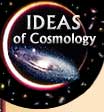
|
|
 |
Why
Hubble's Distances Were Too Small |

|
|
|
The cosmic distance scale established by Edwin Hubble in the 1920s using Cepheid variable stars was changed in the 1950s. For as it turned out, all the distances to spiral nebulae that Hubble had calculated were too small by half. It turned out there are two different types of Cepheid stars. The ones in our galaxy that Shapley had used to calibrate the period-luminosity scale are different from the Cepheids that Hubble found in distant galaxies. This error caused much confusion in the 1940s. For if the nebulae were nearby and receding at the measured velocities, calculating back showed that the universe had started expanding not more than 1.5 billion years ago. This age estimate for the universe, Hubble acknowledged, was clearly less than the age of the Earth, as determined by geologists who measured the radioactivity in rocks. Indeed it was probably less than the age of life on Earth, as estimated by biologists. But it was impossible that the Earth should be older than the universe! Walter Baade made the crucial observation that doubled the distance scale and thus resolved the problem that the universe seemed too young. Baade was born in Germany, took his doctoral degree at Göttingen in 1919, and worked for 11 years at the Hamburg University observatory. He emigrated to the United States and joined the Mount Wilson Observatory staff in 1931. During World War II many of the Mount Wilson astronomers suspended their observations to do military research instead. Baade was excluded as a German citizen from military work, and he now had less competition for use of the world's most powerful telescope. Furthermore, war-time blackouts of Los Angeles at the foot of Mount Wilson enabled Baade to observe exceptionally faint objects in the heavens. Baade discovered that there are two basic types of stars. "Population I" stars are younger, hotter, and bluer. They lie in the spiral arms of galaxies. Hubble had used Population I Cepheid variable stars to determine distances to spiral nebulae. "Population II" stars are older, cooler, and redder. They lie in the centers of galaxies and in globular clusters. Harlow Shapley had used Population II Cepheids to measure the size of our galaxy. Hubble had made the not unreasonable assumption that the Cepheid stars he was observing in spiral nebulae were similar to those observed in our galaxy. In fact, the stars Hubble was using to estimate distances were systematically brighter than the nearer comparison stars. When this was realized in the 1950s, thanks to Baade's work, Hubble's distances were doubled. That brought his figures closer to the age of the universe as measured in other ways ( it was found later that galaxies are even more distant— the universe is about 14 billion years old). |
Copyright ©. Brought to you by the Center for History of Physics, a Division of the American Institute of Physics |
|
|||||